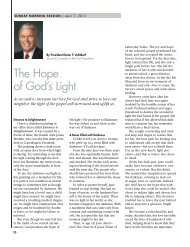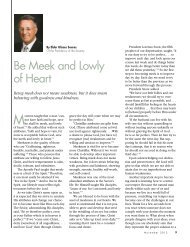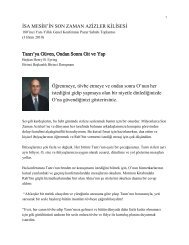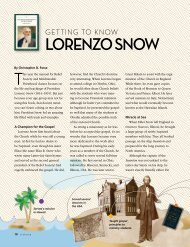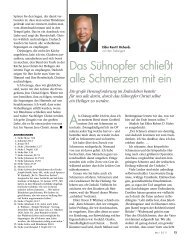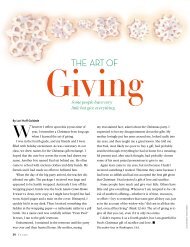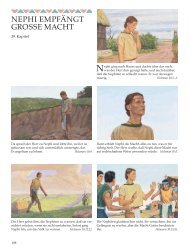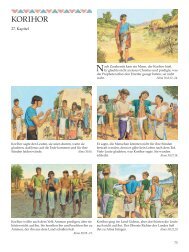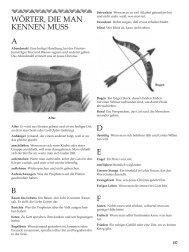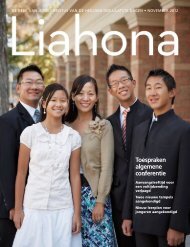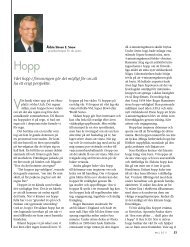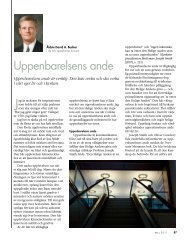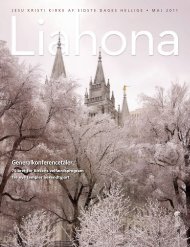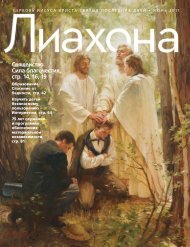April 2005 Ensign - The Church of Jesus Christ of Latter-day Saints
April 2005 Ensign - The Church of Jesus Christ of Latter-day Saints
April 2005 Ensign - The Church of Jesus Christ of Latter-day Saints
Create successful ePaper yourself
Turn your PDF publications into a flip-book with our unique Google optimized e-Paper software.
52<br />
Bishop Kyle<br />
Anderson (left)<br />
with blind<br />
members serving<br />
in Ruston Ward:<br />
Mary Jo Thorpe,<br />
Wayne Pearcy,<br />
Brian Dulude,<br />
Zena Pearcy,<br />
Brook Sexton,<br />
Jeff Pearcy.<br />
It is the same in spiritual endeavors, she<br />
says. Blind people who receive callings in the<br />
<strong>Church</strong> learn to magnify them by using alternative<br />
techniques. She draws a comparison in terms<br />
<strong>of</strong> a common cultural difference. In western society,<br />
people eat certain foods and use a fork. <strong>The</strong>y may<br />
never consider other alternatives. But in Asian societies,<br />
people are accustomed to other foods, eat them with<br />
chopsticks, and get along very well. “Sometimes in the<br />
<strong>Church</strong> I think we need to realize that blind people can<br />
use ‘chopsticks’ and get along fine.”<br />
Zena Pearcy <strong>of</strong>fers a simple example. Some years ago she<br />
served as Primary president in the ward where her family<br />
lived. During sharing time, she could not call on children<br />
simply to raise their hands. So she asked them to raise their<br />
hands and then asked teachers by name to choose someone<br />
from their class to respond.<br />
<strong>The</strong> Pearcys’ son Wayne uses alternative techniques to<br />
solve problems both in and out <strong>of</strong> the <strong>Church</strong>. A skilled<br />
trumpet player who has learned by ear, he marches in his<br />
high school marching band. He has to listen to the people<br />
on either side <strong>of</strong> him in order to be able to stay in line.<br />
Sometimes it is difficult. But he says it is no more difficult<br />
than learning a new route <strong>of</strong> travel <strong>of</strong>f the football field;<br />
there, too, he has to memorize certain routines to go places.<br />
At the sacrament table, he reads the prayers in braille.<br />
He prefers not to rely solely on memory. “Sometimes the<br />
Spirit is really strong up there, so I feel it is better to read<br />
it.” That way he won’t make an error in a prayer.<br />
Brook Sexton, now working in Hawaii, says there is<br />
nothing wrong with priesthood leaders asking blind members<br />
where they feel they could serve. But the answer from<br />
the members may be that they will serve anywhere they<br />
are called. Do other people accept blind members as<br />
teachers and leaders? Sister Sexton’s answer is that they<br />
do if the teacher is prepared. <strong>The</strong> young women in Ruston<br />
accepted her well. “Because I am confident, because I<br />
believe in myself, they trusted me to be a leader.”<br />
Mary Jo Thorpe says blind members are sometimes<br />
seen as “amazing” simply because they can do things that<br />
sighted members do. Instead, they should be expected to<br />
do the same things. <strong>The</strong>y need to stretch their spiritual<br />
and intellectual capabilities just as any other member does.<br />
(She acknowledges, however, that she and others like her<br />
are role models for blind children at the summer camp<br />
where she worked in Ruston. <strong>The</strong> children need to know<br />
blind people who have been successful in school and who<br />
hold productive jobs.)<br />
Rebekah Jakeman <strong>of</strong>fers an example <strong>of</strong> growth that can<br />
come through a calling. While she and her husband were<br />
at Brigham Young University in Provo, Utah, in 2003–4,<br />
Sister Jakeman served in the Relief Society presidency <strong>of</strong> a<br />
student ward where all <strong>of</strong> the presidency were pregnant.<br />
<strong>The</strong> president and second counselor both had their babies<br />
shortly after Sister Jakeman, leaving her to carry out the<br />
presidency’s assignments almost on her own. She developed<br />
ways to fulfill her assignments and learned to rely on<br />
the help <strong>of</strong> other sisters. “I just had to figure out ways to<br />
PHOTOGRAPH BY PAULA ANDERSON



